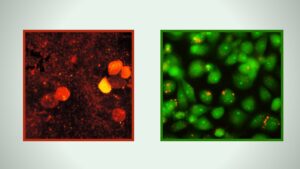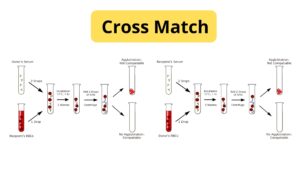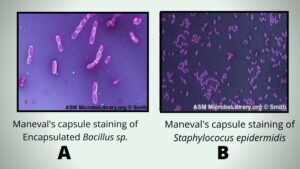What is Western Blotting?
In molecular biology Western blotting is a rapid and sensitive assay for detection and characterization of proteins. This technique exploits the inherent specificity of antigen-antibody interaction to identify specific antigens by polyclonal or monoclonal antibodies.
- Western blotting, also known as immunoblotting, is a fundamental technique in molecular biology and immunogenetics used to detect specific proteins in a sample of tissue homogenate or extract. The technique is not only capable of detecting proteins but also visualizing, distinguishing, and quantifying different proteins within a complex protein mixture.
- To achieve its objective, western blotting relies on three main elements: separation by size, transfer of protein to a solid support, and labeling the target protein using specific antibodies for visualization. The process begins with the separation of proteins based on their size through polyacrylamide gel electrophoresis (PAGE). The proteins are then transferred from the gel onto a solid membrane, typically made of nitrocellulose or polyvinylidene difluoride (PVDF).
- The key to western blotting is the use of antibodies that recognize and bind to specific target proteins. These antibodies, known as primary antibodies, are applied to the membrane after transfer, where they bind to the target protein. After washing off excess primary antibody, a secondary antibody is added, which recognizes and binds to the primary antibody. The secondary antibody is often labeled with an enzyme, which allows for the visualization of the target protein through various methods such as staining, immunofluorescence, or radioactivity.
- The term “western blot” is a play on the Southern blot, a technique for DNA detection, named after its inventor, Edwin Southern. Similarly, the detection of RNA is termed northern blotting. The name “western blot” was coined by W. Neal Burnette in 1981, although the method itself was independently invented in 1979 by groups at Stanford University and the Friedrich Miescher Institute in Basel, Switzerland. The technique has since become one of the most widely used protein analytical techniques, mentioned in hundreds of thousands of publications.
Aim
To learn the technique of Western Blotting for the detection of a specific protein.
Principle of Western Blot – How does western blot work?
- Western blotting, a widely used technique in molecular biology, relies on the principle of protein detection through specific interactions between proteins and antibodies. This method allows scientists to identify and analyze individual proteins within complex biological samples.
- The process begins with the separation of proteins by gel electrophoresis, a technique that sorts proteins based on their size. This is typically achieved using a polyacrylamide gel, which forms a matrix through which proteins migrate when an electric current is applied. Smaller proteins move faster through the gel, while larger proteins move more slowly, resulting in a separation of proteins by size.
- Once separated, the proteins are transferred from the gel onto a solid support membrane, such as nitrocellulose or polyvinylidene fluoride (PVDF). This transfer process is known as blotting. The membrane serves to immobilize the proteins, making them accessible for subsequent detection steps.
- Detection of the target protein on the membrane involves the use of antibodies. The primary antibody, which is specific to the protein of interest, binds directly to that protein. To enhance the detection signal, a secondary antibody is used. This secondary antibody binds to the primary antibody and is typically labeled with a reporter molecule.
- The reporter molecule on the secondary antibody can produce a detectable signal, such as a color change or luminescence, in the presence of a specific substrate. Common reporter molecules include enzymes like horseradish peroxidase (HRP) or alkaline phosphatase (AP), which catalyze reactions that generate visible signals. The signal produced at the antigen-antibody binding site can then be visualized using an appropriate detection system, such as chemiluminescence or colorimetric detection.
- Western blotting is highly sensitive and specific due to the precise interaction between antibodies and their target proteins. This specificity allows for the accurate detection and quantification of proteins, making it a valuable tool in research and diagnostic applications.

Materials Required for Western Blot
| Component | Description |
|---|---|
| Gel Electrophoresis | |
| Gel (NuPAGE) | Used for separating proteins based on size. |
| Basic Power Supply | Provides the necessary voltage for electrophoresis. |
| Sample buffer | Denatures and loads proteins onto the gel. |
| Heating block | Heats samples before loading onto the gel. |
| Sample reducing buffer | Reduces disulfide bonds in proteins. |
| Protein Transfer | |
| Mini Trans-Blot system | Includes a tank, lid, and blot module, stored with cooling ice. |
| 0.45 µm nitrocellulose filter paper | Used for transferring proteins from the gel. |
| NuPAGE transfer buffer | Used for protein transfer. |
| Methanol | Used for protein transfer. |
| Square Pyrex dish and disposable plastic Petri dish | For assembling the transfer system. |
| Razor blade and gel knife | For cutting the gel for transfer. |
| Western Blotting | |
| 10x Tris-buffered saline with 1% Tween 20 | Used for washing and antibody incubation. |
| Shaker | For shaking and mixing solutions during incubation steps. |
| 10% powdered nonfat dry milk | Blocks nonspecific binding sites on the membrane. |
| Square disposable plastic Petri dish | For incubating the membrane with antibodies. |
| Plastic pouches and impulse heat sealer | For sealing membranes with antibodies for incubation. |
| Primary antibody | Binds specifically to the target protein. |
| Secondary antibody conjugated with HRP | Against the host species of the primary antibody. |
| Chemiluminescent substrate | For visualizing HRP activity. |
| Gel documentation system | For imaging and analyzing the results. |
Preparation of buffer and solution
Lysis Buffers
- NP-40 Buffer:
- Contains 150 mM NaCl, 1.0% NP-40 (or 0.1% Triton X-100), and 50 mM Tris-HCl, pH 8.0, along with protease inhibitors.
- Store at 4°C for several weeks or at -20°C for up to a year.
- RIPA Buffer (Radioimmunoprecipitation Assay Buffer):
- Contains 150 mM NaCl, 1% IGEPAL CA-630, 0.5% sodium deoxycholate, 0.1% SDS, and 50 mM Tris-HCl, pH 8.0, along with protease inhibitors.
- Tris-HCl:
- 20 mM Tris-HCl with protease inhibitors.
Running, Transfer, and Blocking Buffers
- Laemmli 2X Buffer/Loading Buffer:
- Contains 4% SDS, 10% 2-mercaptoethanol, 20% glycerol, 0.004% bromophenol blue, and 0.125 M Tris-HCl, pH 6.8 (check and adjust pH if necessary).
- Running Buffer (Tris-Glycine/SDS):
- Contains 25 mM Tris base, 190 mM glycine, and 0.1% SDS, with a pH of 8.3 (adjust if needed).
- Transfer Buffer (Wet):
- Contains 25 mM Tris base, 190 mM glycine, 20% methanol, and 0.1% SDS, with a pH of 8.3 (adjust if needed).
- For proteins larger than 80 kDa, include SDS at a final concentration of 0.1%.
- Transfer Buffer (Semi-Dry):
- Contains 48 mM Tris, 39 mM glycine, 20% methanol, and 0.04% SDS.
- Blocking Buffer:
- Contains 3–5% milk or BSA (bovine serum albumin).
- Add to TBST buffer, mix well, and filter to prevent spotting, which can lead to contamination during color development.
Western Blot test Steps/Western blot protocol
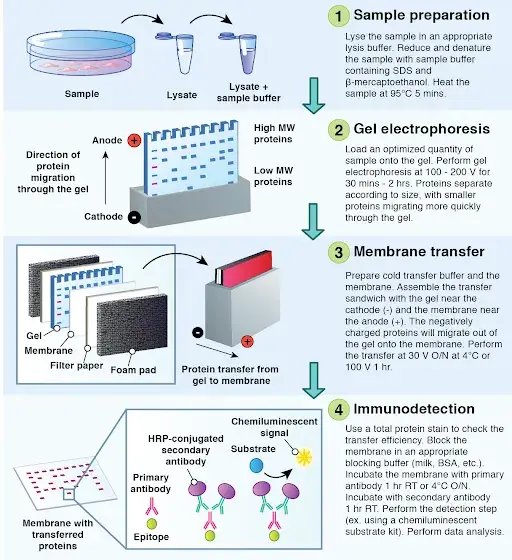
1. Sample Preparation
Sample preparation is a crucial step in Western blotting, as it involves extracting and preparing proteins from samples for analysis. Here’s a detailed explanation of the sample preparation process:
- Cell Lysis:
- The most common samples for Western blotting are cell lysates, which are obtained by extracting proteins from cells.
- Cell lysis can be achieved through mechanical destruction, chemical extraction, or the use of enzymes.
- Extraction is often performed at cold temperatures in the presence of protease inhibitors to prevent protein denaturation.
- Extraction Protocol for Adherent Cells:
- Wash adherent cells in a tissue culture flask or dish with cold phosphate-buffered saline (PBS) and gently rock the flask. Discard the PBS.
- Add PBS to the cells and use a cell scraper to dislodge them. Pipette the mixture into microcentrifuge tubes.
- Centrifuge the tubes at 1500 RPM for 5 minutes and discard the supernatant.
- Add 180 μL of ice-cold cell lysis buffer with 20 μL of fresh protease inhibitor cocktail to the cell pellet.
- Incubate the mixture for 30 minutes on ice, then clarify the lysate by centrifuging for 10 minutes at 12,000 RPM at 4°C.
- Transfer the supernatant (or protein mix) to a fresh tube and store it on ice or frozen at -20°C or -80°C.
- Measure the protein concentration using a spectrophotometer.
- Sample Preparation:
- Determine the volume of protein extract needed to ensure 50 μg in each well of the gel.
- Add 5 μL of sample buffer to the protein sample and adjust the volume in each lane using double-distilled H2O (ddH2O). Mix well. A total volume of 15 μL per lane is suggested.
- Heat the samples with a dry plate for 5 minutes at 100°C to denature the proteins.
2. Gel preparation

- Preparing the Stacking Gel:
- Prepare a 10% stacking gel solution according to the recipe.
- Assemble the rack for gel solidification.
- Add the required amount of ammonium persulfate (AP) and N,N,N’,N’-Tetramethylethylenediamine (TEMED) to the gel solution to initiate gel polymerization.
- Carefully pour the stacking gel solution into the gel cassette until it reaches the green bar that holds the glass plates.
- Add water to the top of the gel to prevent it from drying out.
- Allow the gel to solidify for 15-30 minutes.
- Preparing the Separating Gel:
- After the stacking gel has solidified, remove any excess water from the top.
- Carefully overlay the stacking gel with the separating gel solution, taking care not to disturb the stacking gel.
- Tilt the gel apparatus and use a paper towel to remove any remaining water from the top of the stacking gel.
- Inserting the Comb:
- Insert the comb into the gel, ensuring that there are no air bubbles trapped underneath.
- The comb creates wells in the gel where the protein samples will be loaded.
- Solidification of the Gel:
- Allow the gel to solidify completely before proceeding with electrophoresis.
- The gel is ready when it has a firm, solid consistency.
- Solidification can be checked by gently pressing the surface of the gel with a tube to see if it holds its shape.
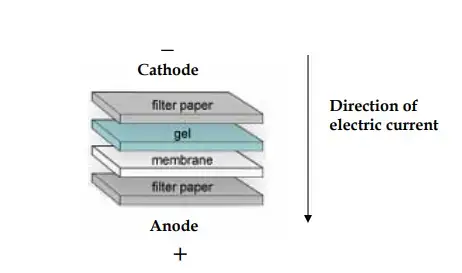
3. Gel Electrophoresis
- Preparing the Gel:
- Prepare a gel by pouring the appropriate gel solution into a gel cassette and inserting a comb to create wells for loading samples.
- Allow the gel to solidify, forming a matrix for the samples to migrate through.
- Preparing the Samples:
- Dilute the protein sample with a sample buffer and denature the proteins by heating and shaking the sample.
- Centrifuge the sample to remove any debris.
- Loading the Gel:
- Pour running buffer into the electrophoresis chamber.
- Place the gel inside the chamber and connect it to a power supply, ensuring the buffer covers the gel completely.
- Carefully remove the comb from the gel.
- Load a molecular weight marker followed by the samples into the wells of the gel.
- Running the Gel:
- Run the gel at a low voltage (e.g., 60 V) to separate the proteins based on size (separating gel).
- After the proteins have entered the stacking gel, increase the voltage (e.g., 140 V) to run the proteins through the separating gel faster.
- Run the gel for approximately an hour or until the dye front runs off the bottom of the gel, indicating that the proteins have migrated through the gel.
- Visualization and Analysis:
- After electrophoresis, the gel can be stained with a dye to visualize the separated proteins.
- The gel can be imaged using a gel documentation system for further analysis and documentation.
3. Protein Transfer
Protein transfer, also known as electrotransfer, is a crucial step in Western blotting where proteins separated by gel electrophoresis are transferred from the gel onto a membrane for further analysis. Here’s a step-by-step guide on how protein transfer is performed:
- Preparing the Transfer Buffer:
- Prepare a transfer buffer by adding 10% methanol to the buffer solution. Methanol is essential for efficient protein transfer.
- Preparing the Transfer Sandwich:
- Cut 6 filter sheets to fit the measurement of the gel, and one polyvinylidene fluoride (PVDF) membrane with the same dimensions.
- Wet a sponge and filter papers in transfer buffer, and wet the PVDF membrane in methanol.
- Lay out the filter papers and sponge in a stack in the transfer case, ensuring they are wet and slightly submerged.
- Place the gel on top of the wet filter paper.
- Carefully place the wet PVDF membrane on top of the gel, ensuring there are no air bubbles between the gel and the membrane.
- Setting Up the Transfer Apparatus:
- Separate the glass plates from the gel and retrieve the gel.
- Place the transfer sandwich into the transfer tank, which should be filled with transfer buffer.
- Ensure that the sandwich is covered with transfer buffer and that there are no air bubbles between the gel and PVDF membrane.
- Running the Transfer:
- Connect the transfer tank to a power supply and set it to 100V for 1 hour. The running time may vary depending on the thickness of the gel.
- The proteins will migrate from the gel onto the PVDF membrane due to the electric field created by the power supply.
- Completing the Transfer:
- After the transfer is complete, disconnect the power supply and remove the transfer case from the tank.
- Carefully remove the PVDF membrane from the gel, ensuring that the transferred proteins remain attached to the membrane.
4. Immunodetection
- Blocking:
- The membrane is washed with a buffer solution to remove any debris or contaminants.
- A blocking solution, typically 5% skim milk in TBST (Tris-buffered saline with Tween-20), is applied to the membrane. This helps prevent nonspecific binding of antibodies and reduces background noise.
- The membrane is incubated with the blocking solution for about 1 hour at room temperature.
- Primary Antibody Incubation:
- The primary antibody, which specifically binds to the protein of interest, is added to the membrane.
- The membrane is then incubated with the primary antibody overnight at 4°C on a shaker to ensure thorough and even binding.
- Washing:
- After the primary antibody incubation, the membrane is washed several times with TBST to remove any unbound antibodies.
- Washing is crucial to reduce background noise and ensure specific binding of the secondary antibody.
- Secondary Antibody Incubation:
- A secondary antibody, which is conjugated to an enzyme such as HRP (horseradish peroxidase), is added to the membrane.
- The membrane is incubated with the secondary antibody for about 1 hour at room temperature.
- The secondary antibody binds to the primary antibody, amplifying the signal and allowing for detection.
- Washing:
- The membrane is washed again with TBST to remove any unbound secondary antibodies.
- Detection:
- An ECL (enhanced chemiluminescence) mix is prepared according to the manufacturer’s instructions.
- The membrane is incubated with the ECL mix for 1-2 minutes, ensuring that the membrane is evenly covered.
- The membrane is then visualized in a dark room using a chemiluminescence imager.
- If the background is too strong, the exposure time can be reduced to improve the clarity of the results.
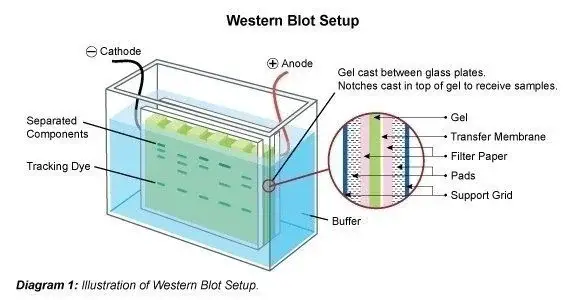

Western Blot Results
- On staining SDS-Polyacrylamide gel, different proteins will appear as dark blue bands against a light blue backgroud.
- On immunodetection, a single blue band will be observed on NC membrane.
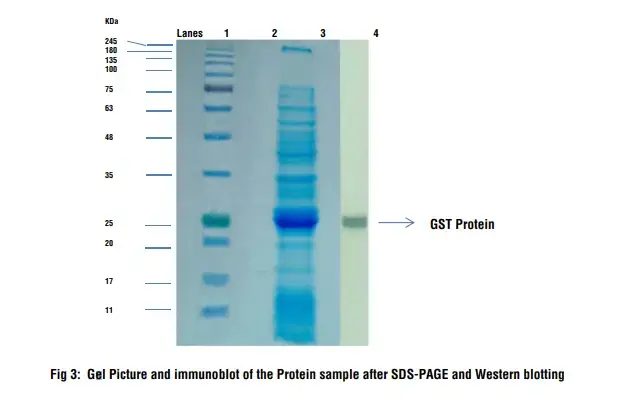
- Lane 1: Prestained Protein Ladder
- Lane 3: Protein Sample
- Lane 4: Immunodetection on the blotted membrane
Interpretation:
After staining and destaining of the gel several bands appear in the sample which is a crude bacterial cell lysate. After performing the Western blotting procedure a thick band can be seen on the nitrocellulose membrane which corresponds to the GST protein which is detected by anti-GST antibody. The molecular weight of GST protein is 26 kD and the position of the band corresponds to the protein size.
Advantages and Disadvantages of western blotting
Advantages of western blotting
- Sensitivity: Western blotting is highly sensitive and can detect small amounts of proteins, making it suitable for analyzing low-abundance proteins and detecting subtle changes in protein expression levels.
- Specificity: The combination of gel electrophoresis and specific antibody-antigen interactions allows for the selective detection of target proteins, even in complex mixtures of proteins.
- Versatility: Western blotting can be used for various applications, including protein expression analysis, protein-protein interactions, and post-translational modifications analysis.
- Quantification: Western blotting can provide semi-quantitative or quantitative data about protein expression levels by comparing the signal intensity of target proteins to internal controls or reference standards.
- Long-term storage: Western blots can be stored and re-probed multiple times, allowing for future analysis or validation of results.
Disadvantages of western blotting
- False or subjective results: Western blots can produce false-positive or false-negative results due to non-specific antibody binding or incomplete transfer of proteins, respectively. Interpretation of the results relies on the expertise and subjective judgment of the technician.
- High cost: Western blotting can be expensive due to the cost of antibodies, specialized equipment (such as imaging systems), and skilled personnel required for the procedure.
- Technical demand: Western blotting requires precise and meticulous execution of each step, including gel electrophoresis, membrane transfer, antibody incubation, and detection. Minor errors or variations in protocols can affect the reliability and reproducibility of results.
- Time-consuming: Western blotting is a time-consuming technique, involving several steps, including gel electrophoresis, transfer, blocking, antibody incubation, and detection. The entire process can take several hours to complete.
- Limited multiplexing: Western blotting typically allows the detection of one or a few target proteins per assay, limiting its ability to simultaneously analyze multiple proteins in a single experiment.
Advantages of western blotting over ELISA
Advantages of Western blotting over ELISA:
- Protein Confirmation: Western blotting directly detects and confirms the presence of specific proteins in a sample. It allows for the analysis of protein size, post-translational modifications, and protein-protein interactions, providing more comprehensive information about the target protein compared to ELISA, which primarily detects protein concentration.
- Sensitivity: Western blotting is known for its high sensitivity, capable of detecting low-abundance proteins in a sample. It can detect protein levels as low as picograms or even femtograms, making it suitable for analyzing samples with limited amounts of protein.
- Specificity: Western blotting utilizes the specificity of antibodies to detect and bind to target proteins. This specificity allows for the selective detection of the protein of interest, even in complex mixtures. ELISA, on the other hand, relies on the specificity of antibodies but primarily measures the concentration of the protein.
- Protein Separation and Characterization: Western blotting combines protein separation by gel electrophoresis with antibody detection, enabling the analysis of protein size and isoforms. This feature is particularly useful for studying protein isoforms, protein cleavage products, or protein modifications, which may have distinct biological functions.
- Flexibility in Sample Types: Western blotting is applicable to various sample types, including cell lysates, tissue extracts, biological fluids, and purified proteins. This versatility allows for the analysis of proteins in different biological contexts and sample matrices.
- Multiple Antibody Detection: Western blotting allows for the detection of multiple target proteins simultaneously by using different primary antibodies raised against different proteins, followed by species-specific secondary antibodies conjugated to different labels. This capability is useful for studying protein interactions, signaling pathways, or protein expression patterns.
- Long-term Storage and Reprobing: Western blot membranes can be stored for future analysis or re-probed with different antibodies to detect additional proteins of interest. This feature offers cost and time savings, as a single blot can be used for multiple experiments.
While ELISA has its advantages, such as high-throughput capacity and quantitative measurement of protein concentration, Western blotting provides unique advantages for protein characterization, sensitivity, and flexibility in sample types. The choice between the two techniques depends on the specific research goals and the nature of the protein analysis required.
Application of western blotting
Uses of western blotting in scientific fields
- Detecting Different Isoforms of Proteins:
- Proteins often have multiple isoforms due to alternative splicing, which can have different functions.
- Western blotting can detect and quantify specific protein isoforms, making it useful for biomarker and therapeutic target studies.
- Detecting Protein-Protein Interactions (PPIs):
- Proteins often function in complexes, and understanding protein-protein interactions is crucial.
- Far-western blotting, derived from standard western blotting, can detect direct PPIs in vitro.
- Detecting Protein-DNA Interactions:
- Transcription factors (TFs) regulate gene expression by binding to DNA in a sequence-specific manner.
- Southwestern blotting (SWB) is used to characterize DNA-binding proteins and TFs.
- Detecting Post-Translational Modifications (PTMs):
- PTMs play a crucial role in protein function and are linked to many diseases.
- Western blotting is used to study PTMs, although multiple assays are often recommended for validation.
- Detecting Proteins’ Subcellular Localization:
- Proteins function properly when localized to specific subcellular compartments.
- Western blotting is used to study protein localization, although it requires validation due to antibody specificity challenges.
- Antibody Development and Epitope Mapping:
- Antibodies are critical for research and diagnostics, and western blotting is used to validate and characterize antibodies.
- Epitope mapping, identifying antibody binding sites on proteins, is essential for vaccine and therapeutic development.
Clinical Applications of western blotting
- Diagnosis of Infectious Diseases:
- Western blotting is used to detect antibodies against infectious agents like HIV, herpes simplex virus, and parvovirus.
- It is also used for nonviral infections caused by bacteria, parasites, and fungi.
- Diagnosis of Noninfectious Diseases:
- Autoimmune diseases can be diagnosed by detecting specific autoantibodies using western blotting.
- Prion diseases, cancer, and other diseases can also be diagnosed based on protein isoform patterns.
Elisa vs Western blot
| Characteristics | ELISA | Western Blot |
|---|---|---|
| Principle | Based on antibody-antigen interaction | Based on antibody-antigen interaction followed by protein separation |
| Detection | Colorimetric or fluorescent signal | Colorimetric, chemiluminescent, or fluorescent signal |
| Sensitivity | Moderate to high sensitivity | High sensitivity |
| Specificity | High specificity | High specificity |
| Sample requirement | Small amount of sample required | Larger amount of sample required |
| Time | Quick turnaround time (few hours) | Longer turnaround time (few hours to overnight) |
| Multiplexing | Can measure multiple analytes simultaneously | Limited multiplexing capabilities |
| Quantitation | Quantitative measurement possible | Semi-quantitative measurement possible |
| Automation | Highly automated process | Some steps require manual handling |
| Cost | Relatively low cost per test | Relatively higher cost per test |
Western blot troubleshooting
Western blotting is a widely used technique for detecting and analyzing specific proteins in a sample. However, it can sometimes encounter various issues and troubleshooting steps are necessary to identify and resolve these problems. Here are some common observations during western blotting and their possible sources and suggestions for troubleshooting:
Observation: No Bands Observed
Possible Source:
- Insufficient antibody: The antibody used may have low affinity to the protein of interest. Increase the antibody concentration 2-4 fold higher than the recommended starting concentration.
- Insufficient protein: Increase the amount of total protein loaded on the gel.
- Poor transfer: Ensure that the PVDF or nitrocellulose membrane is wetted properly in methanol or transfer buffer, respectively. Make sure there is good contact between the membrane and gel.
- Incomplete transfer: Optimize transfer time, as high molecular weight proteins may require more time for transfer. Stain the membrane with Ponceau S, Amido Black, or India Ink to ensure transfer completeness. Use prestained molecular weight markers.
- Over transfer: Reduce voltage or time of transfer for low molecular weight proteins (<10 kDa).
- Isoelectric point is >9: Use an alternative buffer system with a higher pH, such as CAPS (pH 10.5).
- Incorrect secondary antibody used: Confirm the host species and Ig type of the primary antibody.
- Old antibody: If the antibody is expired or past the manufacturer warranty, purchase a fresh antibody.
- Incorrect storage of antibodies: Follow the manufacturer’s recommended storage instructions and avoid freeze/thaw cycles.
- Sodium Azide contamination: Ensure that the buffers used do not contain Sodium Azide, as it can quench the HRP signal.
- Insufficient incubation time with the primary antibody: Extend the incubation time to overnight at 4°C.
Observation: Faint Bands (Weak Signal)
Possible Source:
- Low protein-antibody binding: Reduce the number of washes to a minimum. Decrease the NaCl concentration in the blotting buffer and antibody solution.
- Insufficient antibody: Increase the antibody concentration 2-4 fold higher than the recommended starting concentration.
- Insufficient protein: Increase the amount of total protein loaded on the gel.
- Inactive conjugate: Mix enzyme and substrate in a tube. If color does not develop or is weak, make fresh or purchase new reagents. Consider switching to ECL.
- Weak/Old ECL: Purchase new ECL reagents.
- Non-fat dry milk may mask some antigen: Decrease the milk percentage in the blocking and antibody solutions or substitute with 3% BSA.
Observation: Extra Bands
Possible Source:
- Non-specific binding of primary antibody: Reduce the primary antibody concentration. Reduce the amount of total protein loaded on the gel. Use monospecific or antigen affinity-purified antibodies.
- Non-specific binding of secondary antibody: Run a control with the secondary antibody alone (omit primary antibody). If bands develop, choose an alternative secondary antibody. Use monospecific or antigen affinity-purified antibodies.
- Non-specific binding of primary or secondary antibodies: Add 0.1-0.5% Tween 20 to the primary or secondary antibody solution. Use 2% non-fat dry milk in the blotting buffer as a starting point to dilute primary and secondary antibodies. Increase the number of washes. Increase NaCl concentration in the blotting buffer. Increase Tween 20 concentration in the wash buffer.
- Aggregation of analyte: Increase the amount of DTT to ensure complete reduction of disulfide bonds. Perform a brief centrifugation.
- Degradation of analyte: Minimize freeze/thaw cycles of the sample. Add protease inhibitors to the sample before storage. Make fresh samples.
- Contamination of reagents: Check buffers for particulate or bacterial contamination. Make fresh reagents.
Observation: High Background
Possible Source:
- Non-specific binding of primary antibody: Use monospecific or antigen affinity-purified antibodies. Block in 5% milk. Adjust the milk or NaCl concentrations of the primary antibody solution. Decrease the antibody concentration.
- Non-specific binding of secondary antibody: Run a control with the secondary antibody alone. If bands develop, choose an alternative secondary antibody.
- Insufficient blocking: Start with 5% dry milk with 0.1-0.5% Tween 20, 0.15-0.5M NaCl in 25mM Tris (pH 7.4). Adjust the blocking conditions as needed.
- Non-fat dry milk may contain target antigen: Substitute with 3% BSA.
- Non-fat dry milk contains endogenous biotin and is incompatible with avidin/streptavidin: Substitute with 3% BSA.
- Some IgY antibodies may recognize milk protein: Substitute with 3% BSA.
- Insufficient wash: Increase the number of washes. Increase Tween 20 concentration in the wash buffer.
- Non-specific binding of primary antibody: Increase NaCl concentration in the primary antibody solution and blotting buffer.
Observation: Diffuse Bands
Possible Source: Excessive protein on the gel: Reduce the amount of protein loaded.
Observation: White Bands (ECL method)
Possible Source: Excessive signal generated: Reduce antibody or protein concentration. Excessive antibody or protein can cause extremely high levels of localized signal, resulting in white bands when exposed to film.
Observation: Patchy uneven spots all over the blot
Possible Source:
- Contamination of reagents: Check buffers for particulate or bacterial contamination. Make fresh reagents.
- Not enough solution during incubation or washing: Ensure the membrane is fully immersed during washes and antibody incubations.
- Air bubble trapped in the membrane: Gently remove any air bubbles, especially during transfer.
- Uneven agitation during incubations: Ensure uniform agitation by placing on a rocker/shaker.
- Contaminated equipment: Make sure the electrophoresis unit is properly washed. Wash the membrane thoroughly to remove any protein or gel residues.
- HRP aggregation: Filter the conjugate to remove HRP aggregates.
- Long exposure: Reduce exposure time.
These troubleshooting suggestions can help identify and resolve common issues encountered during western blotting, enabling more accurate and reliable protein detection.
Western Blotting vs Southern Blotting
| Characteristics | Western Blotting | Southern Blotting |
|---|---|---|
| Purpose | Detects and analyzes specific proteins in a sample | Detects and analyzes specific DNA sequences in a sample |
| Target molecules | Proteins | DNA |
| Technique | Uses antibodies to detect and bind target proteins | Uses DNA probes to detect and bind target DNA sequences |
| Separation method | Protein separation by gel electrophoresis | DNA separation by gel electrophoresis |
| Transfer to membrane | Protein transfer from gel to PVDF or nitrocellulose membrane | DNA transfer from gel to nylon or nitrocellulose membrane |
| Hybridization | Antibodies bind to target proteins on the membrane | DNA probes bind to target DNA sequences on the membrane |
| Detection | Enzyme-conjugated secondary antibodies generate a signal | Radioactive or fluorescent probes generate a signal |
| Sensitivity | High sensitivity, can detect small amounts of proteins | Moderate sensitivity, can detect specific DNA sequences |
| Target specificity | Specific binding to target proteins | Specific binding to target DNA sequences |
| Application | Protein expression analysis, protein-protein interactions | DNA sequence analysis, DNA fragment identification |
FAQ
What is Western blotting?
Western blotting is a laboratory technique used to detect and analyze specific proteins in a biological sample.
What is the principle behind Western blotting?
Western blotting involves separating proteins by size using gel electrophoresis, transferring them to a membrane, and then using specific antibodies to detect the target proteins.
What are the steps involved in performing a Western blot?
The typical steps include sample preparation, protein separation by gel electrophoresis, transfer to a membrane, blocking to prevent non-specific binding, incubation with primary and secondary antibodies, and detection of protein bands.
What type of samples can be used for Western blotting?
Western blotting can be performed on a variety of samples, including cell lysates, tissue homogenates, serum, plasma, and purified protein samples.
What are the applications of Western blotting?
Western blotting is commonly used in molecular biology research to study protein expression, protein-protein interactions, and post-translational modifications. It is also used for clinical diagnosis and drug development.
How is protein size determined in Western blotting?
Protein size is determined by comparing the migration of protein standards (molecular weight markers) run alongside the sample proteins on the gel. The size can be estimated by comparing the migration distance of the protein bands.
What is the role of antibodies in Western blotting?
Antibodies are used to specifically bind to the target proteins of interest. Primary antibodies recognize the target protein, while secondary antibodies conjugated with a detection molecule provide a signal for visualization.
What are the detection methods used in Western blotting?
Various detection methods are used, including colorimetric (enzyme substrates), chemiluminescent (enzyme-catalyzed light emission), and fluorescent (fluorescently labeled antibodies) detection.
How can I troubleshoot common issues in Western blotting?
Common issues include non-specific binding, weak or no signal, high background, and band distortion. Troubleshooting strategies involve optimizing antibody concentration, blocking conditions, washing steps, and protein sample quality.
Can Western blotting provide quantitative results?
Western blotting is primarily a semi-quantitative technique. However, with appropriate calibration and densitometry analysis, it can provide relative quantification of protein expression levels.
References
- Mahmood T, Yang PC. Western blot: technique, theory, and trouble shooting. N Am J Med Sci. 2012 Sep;4(9):429-34. doi: 10.4103/1947-2714.100998. PMID: 23050259; PMCID: PMC3456489.
- https://iubmb.onlinelibrary.wiley.com/doi/full/10.1002/bmb.21516
- https://www.bosterbio.com/protocol-and-troubleshooting/western-blot-principle
- https://himedialabs.com/td/hti009.pdf
- http://www.ispybio.com/search/protocols/WesternBlotting.pdf
- https://en.wikipedia.org/wiki/Western_blot
- https://www.mybiosource.com/learn/westernblotting
- https://www.antibodies.com/western-blotting
- https://www.creative-proteomics.com/blog/index.php/the-principle-and-procedure-of-western-blot/
- https://www.sinobiological.com/category/wb-procedures#:~:text=To%20perform%20a%20Western%20Blot,%2C%20(8)%20Data%20analysis.
- https://www.h-h-c.com/western-blot-procedures-analysis-and-purpose/
- https://www.abcam.com/protocols/general-western-blot-protocol
- https://www.thermofisher.com/in/en/home/life-science/protein-biology/protein-biology-learning-center/protein-biology-resource-library/pierce-protein-methods/overview-western-blotting.html
- https://www.novusbio.com/support/support-by-application/western-blot/protocol.html
